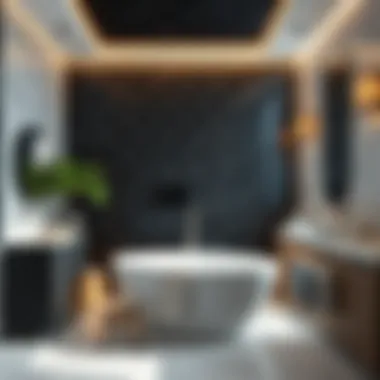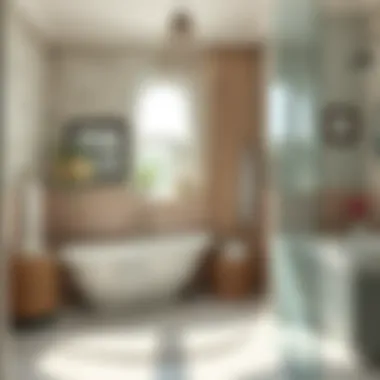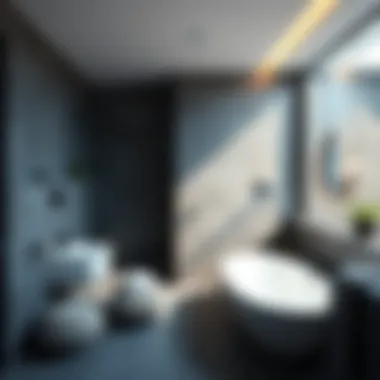A Comprehensive Guide to Bathroom Remodeling


Intro
You might be thinking, "Where do I even start?" The first thing to do is gather all your materials and plan your approach. Consider your needs, styles you admire, and, of course, your budget.
The remodel process can feel overwhelming at times. From starting with the materials to enjoying the final result, making wise choices along the way is essential. Along the way, you will learn the ins and outs of what makes a bathroom both functional and aesthetically pleasing.
In this guide, we delve deep, starting with a clear list of essentials and then walking through each stage, ensuring that you leave the project with a space you love. Ready to dive in? Let’s get to work.
Prelude to Bathroom Remodeling
Remodeling a bathroom is more than just a cosmetic update. It can significantly enhance functionality, transform aesthetics, and increase property value. Understanding the nuances of bathroom remodeling is essential for homeowners, especially those who might not have prior experience in design or renovation projects. This section yields insight into the significance of thoughtful design and practical considerations.
Importance of Bathroom Design
When discussing the importance of bathroom design, it is crucial to understand that the bathroom is often one of the most-used spaces in a home. Ideally, a well-designed bathroom should successfully balance functionality and style. For instance, amidst the hustle and bustle of daily life, a serene, organized bathroom can provide a much-needed oasis.
Key elements of effective bathroom design include:
- Space Utilization: Making sure every inch counts is vital. Appropriate placement of fixtures can create an illusion of space, making a small bathroom feel larger.
- Accessibility: A bathroom should cater to the needs of all family members, including accessibility for the elderly or mobility-impaired individuals.
- Aesthetic Appeal: Trends in tile design, color schemes, and fixtures can turn a dull bathroom into a stylish retreat. Personal choices can be highlighted through colors and textures that encourage relaxation.
The design decisions made during the remodeling process often echo throughout other areas of the home as well. For example, a modern color palette in the bathroom can influence a cohesive style throughout an entire floor. Hence, a good design not only augments a bathroom's functionality but also enhances its visual harmony with adjacent spaces.
Common Reasons for Remodeling
Deciding to remodel a bathroom can be rooted in a variety of motivations. Knowing these reasons can guide homeowners in making informed choices that align with their personal situations. Here are a few common drivers:
- Outdated Features: Many homeowners find that their bathrooms reflect aging fixtures or styles that no longer suit modern preferences. This can lead to a desire to modernize the space.
- Increased Functionality Needs: As families grow, so do their needs. Additional storage, dual sinks, or even an expanded shower might be high on the wish list for families with busy morning routines.
- Enhancing Home Value: A remodel can often yield a notable return on investment when selling the property. Potential buyers frequently appreciate updated bathrooms, considering them as crucial selling points.
- Improving Energy Efficiency: New fixtures and appliances can significantly reduce water and energy usage, contributing to environmentally conscious homeowners’ desires.
- Personal Enjoyment: Sometimes it’s simply about creating a personal retreat within the home. A beautifully designed bathroom can serve as a peaceful getaway.
"Investing in a remodel can be a wise choice for personal comfort as well as increasing your home's value."
Considering the variety of underlying motivations, it becomes clear that remodeling is not merely about aesthetics; it’s about crafting an environment that meets your current lifestyle needs while preparing for the future. Understanding these drivers can help in aligning your remodeling project with your personal goals.
Initial Considerations Before Remodeling
Before diving headfirst into a bathroom remodel, taking a moment to ponder on the initial considerations is not just a luxury but a necessity. It’s the foundation upon which the entire project hinges. Spending time here can save not just money, but also sanity in the long run. By thoughtfully examining specific elements before starting, homeowners can avoid common pitfalls and clarify their vision. This stage sets the tone for a successful remodel by aligning the project’s scope with personal expectations and practical constraints.
Assessing Current Space
One of the first steps in this process is to assess the current space. This isn't merely about measuring walls or counting bathroom tiles; it’s about understanding how the space functions and feels right now. Ask the hard questions: Is there enough storage? Do you frequently run into issues during morning rush hour? Are the fixtures laid out conveniently?
When evaluating your bathroom, point out its strengths and weaknesses. Take notes on the layout, lighting, and flow. Consider what items are frequently used and how their placement affects your routine. Noticing these details allows for better planning, and it’s quite enlightening to see how little changes can create a world of difference in your daily life.
Defining Goals for the Remodel
As you set your sights on redesigning your bathroom, defining clear goals becomes key. Are you aiming for a spa-like retreat, or is the focus more on boosting property value? Clarity here can help tremendously, guiding choices related to style, function, and even budget.
Creating a simple list of goals might streamline the remodeling process:
- Functional improvements: Increase storage, redesign layout for better flow.
- Aesthetic enhancements: Modern finishes, stylish fixtures.
- Sustainability focus: Energy-efficient appliances, water-saving fixtures.
This blueprint not only helps homeowners stay on track but also aligns expectations with the eventual reality of the remodel. When you have a clear vision, the decisions you face along the way become easier to navigate.


Determining Budget Constraints
When it comes to remodeling, money talks. Determining budget constraints should never be an afterthought. It’s essential to set that budget upfront, clearly defining how much is feasible. Avoid the temptation to underestimate this aspect; many homeowners dig themselves a financial hole without realizing how quickly costs can escalate.
Consider the following tips to better manage your budget limitations:
- Set a firm maximum: Identify the highest amount you can spend.
- Include a contingency: Set aside 10-20% for unexpected expenses.
- Prioritize needs over wants: Decide what’s necessary versus what’s desirable.
By laying down a solid financial foundation, you can enjoy the process of remodeling rather than being bogged down by surprises. A well-defined budget keeps the project aligned with reality, ensuring no one is left with an unfinished bathroom and an empty wallet.
A well-planned remodel not only enhances your space but also adds value to your home.
Developing a Design Plan
Creating a design plan is a cornerstone of any successful bathroom remodel. Proper planning serves as a compass throughout the remodel process, ensuring all decisions align with aesthetic aspirations and functional necessities. An effective design plan not only helps to streamline the entire project but also minimizes the chances of costly mistakes. Its importance cannot be overstated.
The design plan shapes the overall look and feel of the space. It encapsulates everything from the choice of colors to the arrangement of fixtures. This is where your vision comes to life. Ultimately, the importance of a well-thought-out design plan lies in its ability to balance creativity with practicality.
Choosing a Design Style
The first step in developing your design plan is selecting a design style that speaks to you. Whether it’s modern, classic, farmhouse, or something eclectic, the chosen style sets the tone for all other design decisions. You want to create a cohesive atmosphere that resonates well with your personal taste.
Consider these elements while choosing your style:
- Color scheme: Different styles demand different palettes. For instance, modern styles may lean towards cool colors, while traditional may favor warmer tones.
- Material preferences: The type of materials you select can elevate the design. For example, if you favor a rustic look, consider incorporating reclaimed wood or stone.
- Fixtures and accessories: Elements like faucets, mirrors, and lighting can either make or break the design. Choose those that align with your style.
One common pitfall in this phase is attempting to merge styles that don’t naturally sync. It’s essential to harmonize elements rather than create a mismatched visual.
Creating a Floor Plan
Once the style is set, turning to the floor plan becomes critical. This step involves thinking about how space will be utilized. A thoughtful layout can make the difference between a cramped, uncomfortable area and a room that feels open and inviting.
Begin by measuring your space accurately, taking into account existing elements like windows and doors. Sketch out various arrangements of fixtures like toilets, sinks, and bathtubs. Consider factors like:
- Traffic flow: Ensure sufficient space for people to move freely; there’s nothing worse than a kitchen table in a tiny kitchen, making it feel like a sardine can.
- Functionality: Design a layout that accommodates your lifestyle. If you’re often multi-tasking, a double sink might be in order.
Ultimately, the floor plan must cater to both comfort and utility, ensuring that every square foot serves a purpose. You could even use CAD software or apps for a clearer visualization.
Selecting Fixtures and Materials
After finalizing the floor plan, it’s time to select fixtures and materials that will bring your design to life. Fixtures include anything you’ll be using regularly, such as sinks, bathtubs, and lighting. Materials encompass everything from tiles to countertops.
When choosing fixtures,
- Prioritize quality over looks: While it’s tempting to choose aesthetic fixtures, durability is key for bathroom elements that will see daily use.
- Stylish functionality: Look for designs that serve both purposes; a beautiful bathroom faucet shouldn't compromise on how efficiently it functions.
As for materials, keep in mind:
- Maintenance: Certain materials, while trendy, may entail more upkeep. Porcelain tiles may look stunning but can require grouting and regular cleaning.
- Longevity: Consider investing in high-quality materials to ensure they withstand the test of time. You don’t want to deal with replacing worn-out elements after just a few years.
"Thoughtful selection of fixtures and materials can significantly enhance not just the aesthetic but also the functionality of your space."


In summary, a well-prepared design plan acts as a road map, smoothing the path ahead. By choosing a coherent design style, creating a practical floor plan, and thoughtfully selecting fixtures and materials, you lay a solid foundation for a successful bathroom remodel.
Hiring Professionals vs. DIY
The decision between hiring professionals or taking on a bathroom remodel as a DIY project isn't a simple one. Each option has its own set of benefits and considerations that can significantly impact the outcome of your remodeling endeavor. Understanding these factors is vital as you embark on this journey, specifically if you're looking to balance personal satisfaction with budget constraints.
Evaluating Skill Level for DIY
Before jumping headfirst into renovations, it’s crucial to take a step back and honestly evaluate your skills. This self-assessment can save you a lot of headaches down the line. Consider questions such as, What skills do I have? or Am I comfortable working with tools? Many individuals may feel confident with painting or installing a new vanity but may find plumbing or electrical work daunting.
Given that the bathroom is often a space with high water usage and electrical components, finesse and a solid understanding are paramount. An amateur mistake can lead to costly repairs down the road. For instance, misfitting pipes can cause leaks, which could lead to damages that surpass the cost of hiring a professional from the get-go.
In short, if you’re well-versed in home improvement tasks, the DIY route could be feasible, but if you’re uncertain, it might be wise to consider hiring an expert. Be honest with yourself—there's no shame in knowing your limits.
Finding Qualified Contractors
If DIY isn't in your wheelhouse, or you desire a high-quality finish without the potential mishaps, finding a qualified contractor is your next step. Navigating through contractor options can feel like looking for a needle in a haystack, but it doesn't have to be that tough.
Start by asking friends or neighbors who’ve recently completed similar projects for recommendations. Online platforms such as platforms like Facebook or local sites can serve as resources for community feedback on various contractors. Gather a list, then seek estimates from multiple professionals. Remember to check references from past clients and ensure that they have the right credentials. It gives you peace of mind to know they've tackled projects like yours before.
Don't hesitate to ask questions during the interview process about their approach, timelines, and potential unexpected issues. A qualified contractor will give clear answers and maintain open communication. After all, while you’re handing over a significant investment, ensuring that you pick the right person can make or break your experience.
Understanding Legal Requirements
One often overlooked aspect of bathroom remodeling is the necessary legal requirements. Ignoring permits and codes can lead to substantial headaches—or worse—legal trouble. Depending on where you reside, extensive renovations might require specific permits, especially if they involve plumbing or electrical work.
It's essential to familiarize yourself with local regulations before the demolition phase begins. Ignorance isn’t bliss in this case. Many areas require inspections at various stages of the project, and ensuring compliance can save you from costly fines or having to redo work.
Also, when hiring a contractor, make sure they are up to snuff on local code requirements. Ask them about their experience with the permit process and if they've handled projects that required inspections before. Having someone on board who knows the legal side can simplify your life immensely and save you time and stress.
To wrap it up, evaluating your skills, finding reliable professionals, and understanding legal requirements are three pivotal steps in the remodeling process. By carefully considering these factors, you can pave the way for a successful bathroom transformation.
Navigating the Remodeling Process
Grasping the nitty-gritty of the remodeling process is crucial for anyone stepping into the chaotic yet thrilling world of bathroom renovations. This is not just about swinging a hammer and pouring paint, but a carefully orchestrated journey that demands an understanding of every twist and turn. Each phase holds its own significance, and knowing what to expect can help you avoid the pitfalls that leave many homeowners feeling overwhelmed.
The remodeling process begins with a clear vision that transforms into reality through several important stages. The aim is not just to change the look of your bathroom, but to enhance its function and comfort. By navigating through this process with awareness, you can ensure every detail aligns with your vision while keeping everything on track and within budget.
Demolition and Removal
Demolition is where the magic begins—or ends, depending on how you look at it. This stage involves tearing down old fixtures, cabinetry, and potentially tile. It isn’t merely about making a mess; rather, it’s about creating a canvas for fresh ideas. You might think it’s just a matter of ripping stuff out, but there’s plenty to consider here:
- Protecting your surrounding areas from damage. Covering floors and walls can prevent unintentional harm that could turn your remodel into a nightmare.
- Knowing the structural elements in your bathroom. Some walls might be load-bearing, which is crucial to understand before taking a sledgehammer to the room.
- Proper disposal of materials. Make sure to research local regulations regarding waste removal to avoid fines.
"Do not underestimate the impact of a well-planned demolition; it sets the tone for the entire remodel."
It's advisable to have a plan in place before starting. This way, you won’t be standing around wondering what's next.
Plumbing and Electrical Work
After the debris has settled, the next critical phase deals with the plumbing and electrical systems. This is the backbone of your new bathroom. Nothing snuffs out a renovation faster than leaks or blown circuits. Consider these factors:


- Consult specialists to assess your current plumbing and wiring. Often, older homes will have outdated systems that require major upgrades.
- Permits are typically needed for any significant changes in plumbing and electrical work. Following local codes not only keeps you compliant but ensures safety as well.
- Test all new installations. Once the work is completed, running water through new pipes or checking light fixtures should be a top priority.
Understanding the intricacies of this step will give you peace of mind, knowing your bathroom will function efficiently without hiccups down the road.
Installation of New Features
With a solid structure in place, you’re now ready to bring your vision to life. The installation phase is where the aesthetics begin to show. You’ll be dealing with:
- Bathtubs and showers. Choose ones that fit your style and needs. Some might even offer dual features, like a shower head and bathtub combo.
- Vanities and storage solutions. Not only should they match your design, but they should be practical as well. Don’t skimp on storage; less clutter results in a more enjoyable space.
- Flooring and tiles. A range of options exists, from ceramic to vinyl to stone, depending upon your aesthetic and functional goals.
Taking the time to carefully plan and execute this step will make all the difference in achieving a cohesive look that’s both stunning and functional.
Finishing Touches and Aesthetics
Finally, we arrive at the finishing touches—the cherry on top of an already delicious sundae. To wrap up a bathroom remodel, small details play an enormous role:
- Light fixtures can dramatically impact the ambiance. Think carefully about brightness and color temperature.
- Accessories like towel bars, soap dishes, and mirrors. This may seem trivial, but the right touches can elevate your bathroom from bland to breathtaking.
- Paint and decor. Choosing the right colors can evoke the intended mood. Soft pastels might create a calming atmosphere, while bold hues can energize the space.
By giving thought to the finishing details, you’ll create a bathroom that not only meets functional needs but also serves as a retreat from everyday life.
Navigating the remodeling process requires diligence and an eye for detail. Each step holds its own importance, and when combined, they lead to a bathroom that you can be proud of for years to come.
Post-Remodel Adjustments and Maintenance
When all the dust has settled and you've enjoyed that first soak in your newly remodeled bathroom, you might think the journey is at an end. However, maintaining a fresh and functional space goes beyond initial completion. This phase is all about post-remodel adjustments and ongoing maintenance, ensuring your investment continues to pay off while enhancing your comfort and satisfaction.
Evaluating the Outcome
A critical step after any remodel is taking a moment to really evaluate the outcome. Ask yourself, does the bathroom now meet your needs? Think about elements like:
- Functionality: Does everything work as intended? Check fixtures, storage solutions, and layouts. Are they practical for daily use?
- Design: Does the finished look align with what you envisioned? Sometimes what looks good on paper may not translate perfectly into reality.
- Comfort: Are the bathroom's new features making your day-to-day life better? Pay attention to little things like shower pressure, toilet comfort, and lighting.
Talking to family members can also provide insights you might overlook. A keen eye for feedback is invaluable, and it might surface minor tweaks yet to be addressed. Whether it’s an adjustment to the height of a mirror or a matter of adding a few decorative touches, these kinds of evaluations help in keeping the integrity of the remodel intact long-term.
Establishing a Maintenance Routine
Now that you’ve got an aspirational space, the next step is a solid maintenance routine. This isn't just about aesthetics; regular upkeep keeps the usability high and prevents costly repairs down the line. Consider these areas:
- Cleaning Schedule: Establish a consistent cleaning schedule to ward off molds or mildew that can creep in, especially in the humid environment of a bathroom. Use gentle cleansers that won't damage surfaces but still offer a thorough clean.
- Inspect Grouts and Caulking: Over time, grouts can crack and caulk can mold. Regularly check these areas and reapply when necessary to prevent water damage.
- Check Fixtures and Connections: Plumbing can sometimes be fickle. Look for leaks and ensure connections remain tight. A small drip could lead to bigger water bill or damage issues down the line.
Keeping a checklist can make these tasks less daunting. It doesn’t have to be a chore; think of it as a routine that enhances your enjoyment of the space. Regular small fixes often prove more manageable than trying to troubleshoot larger problems later.
Remember, a little bit of attention today can save you heartache tomorrow.
Epilogue
In wrapping up the intricate journey of bathroom remodeling, it's essential to grasp the various nuances that this endeavor entails. Having traversed from the initial planning stages through to post-remodel adjustments, the importance of this conclusion rests not solely in summarizing the process but in reinforcing the principles that help homeowners navigate the remodeling landscape effectively.
Recap of Key Points
- Initial Assessment: Identify your current space and set clear goals for your remodel. Know what works and what does not.
- Budget Planning: Establish a realistic budget. Understand where costs can be cut without compromising quality.
- Professional Help vs. DIY: Weigh your skills against the complexity of the job. Sometimes, it's more cost-effective to hire experts who can ensure a professional finish, especially for plumbing and electrical tasks.
- Execution: Follow through each step, from demolition to the careful installation of fixtures. Haste can lead to mistakes that are both costly and frustrating.
- Post-remodel Evaluation: Assess your new space and establish a maintenance plan to keep everything in tip-top shape.
Final Thoughts on Bathroom Remodeling
Bathroom remodeling is not merely about aesthetics; it's about functionality and personal expression. Every decision, from tiles to lighting, contributes to the overall atmosphere you wish to create. By being informed and methodical, homeowners can turn what might be a daunting task into an enriching experience.
With that said, don't forget the emotional aspect. A newly remodeled bathroom can significantly impact daily routines, turning mundane tasks into mini moments of bliss. It’s a retreat within your home where relaxation and rejuvenation occur. Make choices that resonate with your personality and lifestyle. Also, keep in mind that your preferences may evolve, so opt for timeless elements blended with the latest trends to enjoy long-term satisfaction.
The insights shared here aim to empower you, whether you're a housewife focused on family needs or a homeowner keen on increasing property value. Embrace the challenge, relish the process, and watch as your dream bathroom comes to life!







